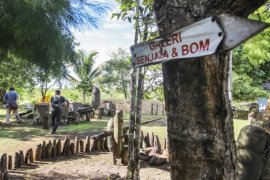The historical World War II sites they visited included a number of caves at Sumberker village, Samofa district, used by Japanese soldiers as shelters, the World War II monument at Anggraidi/ Paray village, Biak City, other tourist locations.
The eleven Japanese who visited Biak were identifies as Nishikubo Manabu (team leader), Kazushi Yamagishi, Iwabuchi Nobuteru, Okubo Harua, Sachio Tanaka, Yoshiko Sakamoto, Kazuki Chida, Yazusima Takashi, Takashi Yasukawa and Ikuyo Sato Saputro.
the Indonesian officials accompanying the Japanese group included Bonifatiayus Heryndra and Herman Djatmiko (foreign affairs ministry) as well as Saiful and Mardit Sianto (home affairs ministry).
The visit of the Japanese tourists to Biak Numfor district, Papua was a routine activity as a follow up of a cooperation accord between the Japanese and Indonesian governments in the framework of bilateral relations between the two countries, especially in the socio-cultural field.
During their visit in Biak Numfor district, the Japanese tourists would also cremate the remains of some Japanese World War II victims.
The ashes of the cremated remains of World War II soldiers would be ifficially handed to the Japanese group at a ceremony at the World War II memorial in Anggraidi/Paray village, Biak City, on Monday, March 14, 2011.
(T.KR-LWA/HAJM/F001)
Editor: Priyambodo RH
Copyright © ANTARA 2011











